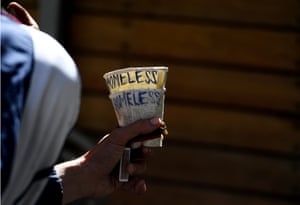Extract from The Guardian
Victorian government’s efforts under fire as scores of people are turned away from homelessness services each day
On a weekday afternoon during Victoria’s state election campaign,
James is slumped against the front of a 7-Eleven store in Melbourne’s
CBD, coughing and spluttering but mostly just lamenting.
“It’s got to the point where I’ve given up trying to look for housing,” he says, sitting about 50 metres from the state parliament. “They always say sorry, ‘There’s nothing available’.”
James has been living on the streets for about 10 years. As Victorians watch the votes coming in on election night, he’ll be among about 400 people sleeping rough in Melbourne’s CBD and inner-city suburbs.
"The services in the city are nothing more than ambulances at the bottom of the cliff"
Most service providers say the Victorian government has made a real effort to tackle homelessness and housing issues in Melbourne. Still, the statistics make for grim reading.“It’s got to the point where I’ve given up trying to look for housing,” he says, sitting about 50 metres from the state parliament. “They always say sorry, ‘There’s nothing available’.”
James has been living on the streets for about 10 years. As Victorians watch the votes coming in on election night, he’ll be among about 400 people sleeping rough in Melbourne’s CBD and inner-city suburbs.
"The services in the city are nothing more than ambulances at the bottom of the cliff"
About 82,000 people are on the state’s public housing waiting list, 24,000 of them children. Last financial year, 118 new apartments were added to the state’s pool of public housing, department data released this month shows. In July, the list was growing by 500 names every month. There was also a 11% increase in homelessness between the 2011 and 2016 census.
“All we’re doing is picking up the pieces and trying to get accomodation for people. But we’re not stopping homelessness, we’re not ending it.”

Earlier in the campaign, Labor promised to build 1,000 public housing units, bringing its total pledge of social and public units to 6,000. The move was welcomed by the sector, but falls well short of the 30,000 that the Victorian Council of Social Service says are needed over a decade. Labor has also promised to pilot a program to provide free public transport for the homeless and disadvantaged.
Jenny Smith, the chief executive of the Council for Homeless Persons, says the government has done a good job and lauds its focus on tackling family violence, the biggest contributor to homelessness.
But she also notes that Victoria has the lowest amount of social housing in percentage terms among all the states. “The national average is around 5.5% [of total housing stock]; we’re at 3.5%,” Smith says. The pledge to build another 6,000 dwellings will only “stop us going backwards”.
Of the Coalition’s plans, Smith says: “I think we’re still to see what they’re going to put forward on this issue.” The opposition was contacted for comment.
Last year, homelessness hit the front pages of the papers in Melbourne when the numbers of people sleeping rough on the CBD’s streets hit crisis point. At the time, the Coalition criticised the state government for abolishing “move on” laws that allowed police to evict so-called “homeless camps”.
The government established a rough sleeping taskforce, which led to a $45m action plan that includes programs to locate rough sleepers and to help the vulnerable stay in their accomodation once they have been housed.
Some parts of Labor’s efforts to solve the state’s housing woes have angered some. A plan to sell public estates across the city to developers, the first stage of a long-term $185m strategy to renew ageing housing stocks, has been criticised by some residents, the opposition and the Greens, which say the 10% uplift in public units was insufficient.
Andrews Hollows, a general manager at Launch Housing, agrees that the “proportion of units needs to be higher”. “We were arguing a 30% uplift at affordable housing and social housing,” he says.
As rents soar in Melbourne, Hollows says another recent development is the “suburbanisation of homelessness and rough sleeping” in the city.
“That’s partly reflecting the ongoing gentrification and urban renewal in the inner parts of Melbourne,” he says.
It has put a serious strain on homelessness services. Smith says 99 people are turned away from homelessness services each day, one in four of whom are children, and providers have seen a 20% increase in people asking for assistance over four years.
At the Salvo’s drop-in cafe on Bourke Street in central Melbourne, there can be up to 200 people sleeping on the floor on some nights.
While there are fewer rough sleepers on the CBD’s streets now than there were in 2017, Nottle says many have simply moved out of the public’s sight.
Of the 210 sleeping rough in the CBD during a recent street count, 167 were on the floor at the Salvo’s cafe.
“There are times when our cafe, which is meant to be a safe place for homeless people, ends up being a psych hospital,” Nottle says.
James drops by when he’s desperate for a meal, although he finds the atmosphere difficult. On the streets, he usually has only one meal a day.
He lifts up his shirt to show a scar from when he had his bowel removed. He worries about being robbed at night and rolling over in his sleep.
“How can you say to someone, ‘Excuse me I need some clothes, my bag’s burst’,” he says. “I was on a tram, and the tram jolted and ‘bang’. It was the worst day of my life.”
Recently, someone stole his sleeping bag. “I don’t even have a blanket,” he says. “I put my hood over the top and try and put something under my feet because the cold comes up through the concrete.”


No comments:
Post a Comment